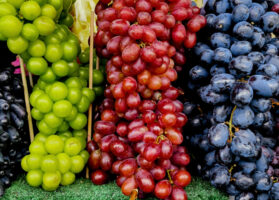Naturipe begins Chilean blueberry season with high expectations
Overview of blueberries from Chile in the U.S. market, complemented by charts from Agronometrics. Original published on October 6, 2022.
Naturipe’s Chilean blueberry season will run from October to April, says Jim Roberts, president of sales, and the company will offer strong volume most of that time.
“We should see the peak arrivals start to hit by mid-December and last through mid to late February,” Roberts said.
Naturipe starts its blueberry production in the north of Chile, in Region 2, and then will transition to Central Chilean Regions south of Santiago. Harvest will then finish up in the South of Chile in Osorno, which is Region 10, he said.
“Due to this diversity in regions, we harvest at peak supply from at least one of the regions through most of the Chilean season,” Roberts said. “The peak supply is just beginning and will continue through early spring.”
The U.S. is the largest market for the company’s Chilean blueberries, but the marketer also ships to Europe, Asia and local markets in South America.

Source: USDA Market News via Agronometrics.
(Agronometrics users can view this chart with live updates here)
“Here at Naturipe, we are extremely excited about our continuation of new proprietary varieties that are being planted in all of our production regions, including Chile,” Roberts said. “These new varieties are bigger, firmer, sweeter and are the results of significant time and investments our owners have made for more than a decade. We are finally starting to see the fruits of our labor, so to speak.”
Roberts said that logistical delays should be lessened this year.
“There will always be some delays that are driven by the impacts of weather, particularly into the Northeast,” he said. “However, we should see significant improvements this year overall with the addition of the Blueberry Express (ocean shipping) service that we will be using on both the East and West Coast, which will get imported blueberries to the U.S. significantly quicker than ever before.”
The Blueberry Express service, he said, will have a positive impact on the shelf life and quality of the fruit.
“We are extremely excited to be able to have this new service available and what this will mean in terms of a better eating experience for the consumer, as well as improved results for our growers,” Roberts said.
With the increased production from Peru of both conventional and organic blueberries, nearly all Naturipe’s blueberry shipments from Chile will be shipped in ocean containers, Roberts said. That is another reason the company is excited to have the Blueberry Express service in place, Roberts said.
ORGANIC IMPORTANCE
Chile is an especially important area for organic blueberries because growers there fill the gap in supply between when Peru finishes production and before Florida, California and Mexico start production, Roberts said.
The U.S. is the largest market for Chilean blueberries, followed by Asia and Europe.
“Naturipe Organic Blueberries from Chile to the United States make up a significant percentage of the total crop, as the United States has a higher demand for organic than anywhere else in the world today,” he said.
RETAIL PROMOTION
Retailers can create a fall berry patch in the produce section to boost blueberry sales, Roberts said.
“This highlights the berries that are in season, including our Chilean blueberries, all in one place,” Roberts said. “We also recommend that retailers spotlight all the benefits of blueberries — they’re packed full of antioxidants, they’re high in manganese, and they’re a great source of fiber.”
The average consumer is looking to incorporate more health into their everyday diet with blueberries, he said, and the use of blueberries in baking is also popular.
“Parents of young children are especially big fans of blueberries because of how easy they are for kids to feed to themselves,” Roberts said.
CONCERNS AND HOPES
Roberts said Chilean blueberry growers face the common industry challenges of rising costs and the impacts of inflation that are challenging their ability to be profitable and continue to farm.
“Growers’ returns have, for the most part, not kept pace with the increased cost of growing the crop, harvesting the crop, packaging the crop, and shipping to market, which is not sustainable for long-term success,” Roberts said. “We as an industry have to then pass the cost increase on to our customers and consumers in order to continue to grow berries, which is a pressure many are feeling across the supply chain.”
Looking ahead, Roberts said he expects there to be a continued focus on variety replacement and improvement for Chilean Naturipe blueberries, in addition to continued efforts to optimize logistics to get fruit to the market as quick as possible to ensure the consumer has a great eating experience.
The News in Charts is a collection of stories from the industry complemented by charts from Agronometrics to help better tell their story.
Access the original article with this (Link)






